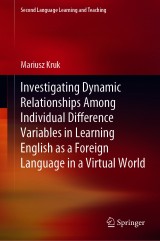Details

Investigating Dynamic Relationships Among Individual Difference Variables in Learning English as a Foreign Language in a Virtual World
Second Language Learning and Teaching
|
106,99 € |
|
| Verlag: | Springer |
| Format: | |
| Veröffentl.: | 19.01.2021 |
| ISBN/EAN: | 9783030652692 |
| Sprache: | englisch |
Dieses eBook enthält ein Wasserzeichen.
Beschreibungen
<div>This book focuses on the dynamic relationships among individual difference (ID) variables (i.e., willingness to communicate, motivation, language anxiety and boredom) in learning English as a foreign language in the virtual world Second Life. The theoretical part provides an overview of selected issues related to the four ID factors in question (e.g., definitions, models, sources, types, empirical investigations). The empirical part reports the findings of a research project which aimed to examine the changing nature of WTC, motivation, boredom and language anxiety experienced by six English majors during their visits to the said virtual world, the main contributors to the changes in the levels of the constructs under investigation, as well as their relationships. The book closes with the discussion of directions for further research as well as pedagogical implications.<br></div>
1. The constructs of willingness to communicate, motivation, boredom and language anxiety: Overview of selected issues.- 2. Empirical investigations into WTC, motivation, boredom and language anxiety in traditional and digital contexts.- 3. Design of the study.- 4.Findings of the study.- 5. Conclusions, pedagogical implications and directions for future research.
Mariusz Kruk, University of Zielona Góra, Zielona Góra, Poland.
<div>This book focuses on the dynamic relationships among individual difference (ID) variables (i.e., willingness to communicate, motivation, language anxiety and boredom) in learning English as a foreign language in the virtual world Second Life. The theoretical part provides an overview of selected issues related to the four ID factors in question (e.g., definitions, models, sources, types, empirical investigations). The empirical part reports the findings of a research project which aimed to examine the changing nature of WTC, motivation, boredom and language anxiety experienced by six English majors during their visits to the said virtual world, the main contributors to the changes in the levels of the constructs under investigation, as well as their relationships. The book closes with the discussion of directions for further research as well as pedagogical implications.<br></div>
Is groundbreaking in that it explores the changes in the constructs of willingness to communicate, motivation, language anxiety, and boredom in a virtual world, which still remains under-researched and insufficiently understood, with little empirical research being undertaken, particularly in the context of virtual environments Uncovers the relationships among willingness to communicate, motivation, language anxiety, and boredom as well as factors responsible for them in the virtual world Second Life Offers instructional options for increasing willingness to communicate and motivation and decreasing the experience of boredom and language anxiety in virtual environments Provides valuable guidelines for researchers interested in conducting similar research


















